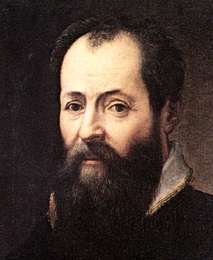MAY 24, 2020 – I’m about to plunge into a self-directed study of . . . the Renaissance, or “rebirth”; the period of a grand flowering of arts and letters during the fourteenth, fifteenth, and sixteenth centuries, emanating from the Italian city-states. I knew, of course, that “renaissance” means “rebirth,” but until my current binge reading I didn’t know that it was Giorgi Vasari (1511 – 1574)(pictured above), the Florentine painter, architect, writer, and historian, who coined the word to describe his times. Actually, the word he used was “la Rinascita,” which, you guessed it, is Italian for “Renaissance.” It was Denis Diderot’s Encyclopédie (1751 – 72) that first definitively used “Renaissance” to characterize the period. The French version stuck—at least with the French and many of us non-French.
What I find so fascinating are the why and how of the Renaissance. Why did it originate in northern Italy? How did it get rolling? What sustained it? Who drove it? Sure, we’re all familiar with the soaring names of Da Vince, Raphael, Titian, Michelangelo, Donatello, Brunelleschi, and Botticelli, but what about the conditions and the people who paved the way, created the demand, and sustained the work of these and other Renaissance artists?
As one historian concludes, money is the root of all civilization; more specifically, for the Renaissance to find traction, there had to be profits of skillful managers and underpaid labor. This “surplus” was the essential prerequisite for the arts to flourish.
Other essential ingredients were the rise of secularism associated with an expanding middle class; growth in universities and attendant growth in knowledge, philosophy, the study of law and ever widening understanding of the world.
Northern Italy, with its commerce and industry, was the richest part of the Christian world. Thanks to its location, it served as the trade route between the rest of Italy and Europe on the other side of the Alps. From Mediterranean ports, Venetian and Genoese traders traveled to far off places, and in the process, brought back not only exotic goods sold at huge profit but a burgeoning knowledge and curiosity of the world beyond the horizon. Moreover, because full-on feudalism had never taken hold in northern Italy, cities and their merchants held greater sway over landed nobility.
Then came the political rivalries among and within cities. These pitched battles, often among families, had distinct downsides (think raw violence) but also advantages: they kept everyone on their toes—and stirred their intellects and imaginations.
Throw into the mix Cosimo Medici (1389 – 1464), whose business prowess, extreme wealth, and political power were matched by his interest in the arts, literature, and philosophy. He was most definitely a philosopher—“lover of knowledge.” He and his progeny contributed much to . . . the Renaissance.
I haven’t even scratched the surface. I’ve only removed some of the wrapper. Before the scratching starts, however, I’m reminded that with trade and commerce—lifeblood of the Renaissance—came rats, fleas and plague.
And now . . . back to the latest news on Corvid-19.
(Remember to subscribe to this blog and receive notifications of new posts by email.)
© 2020 by Eric Nilsson
